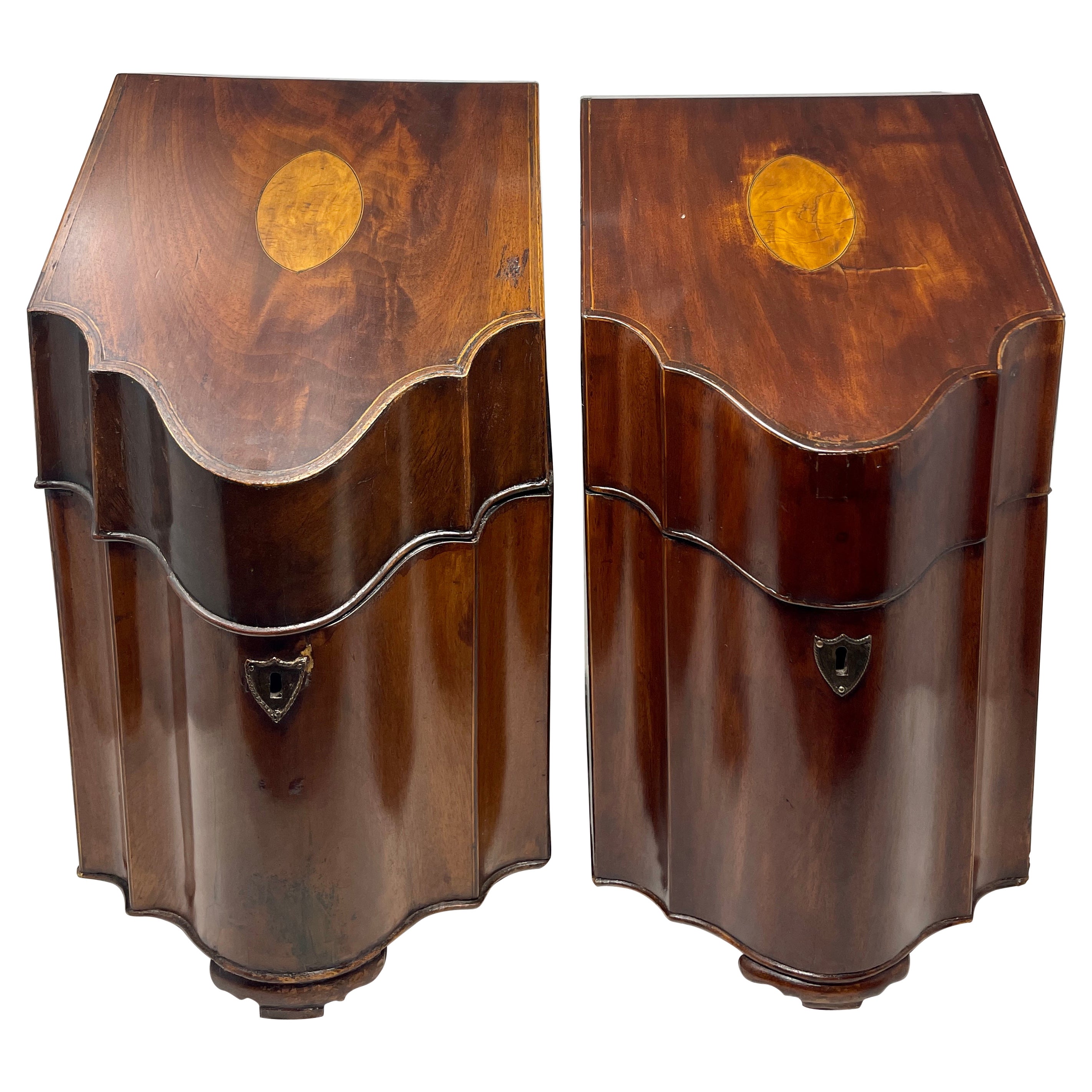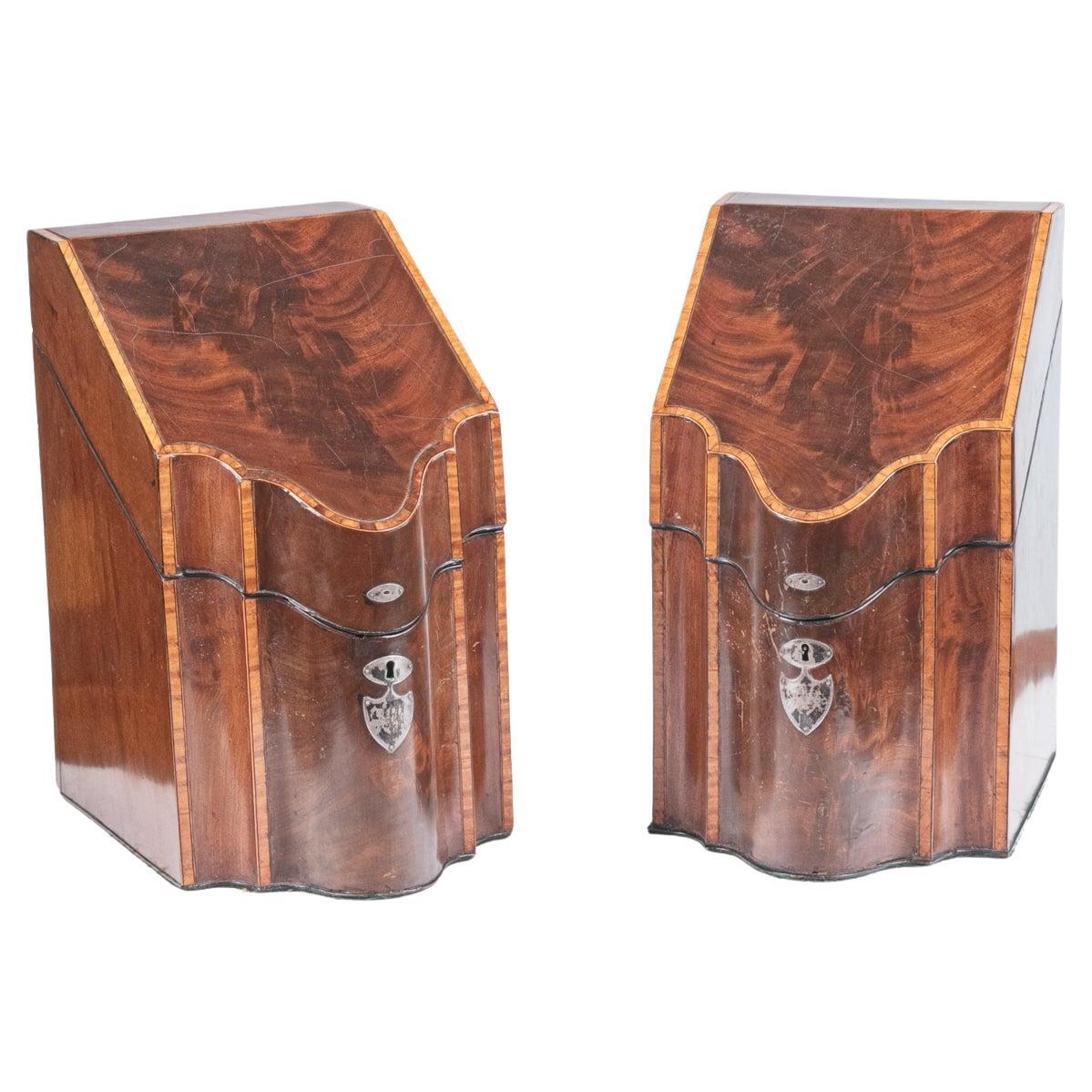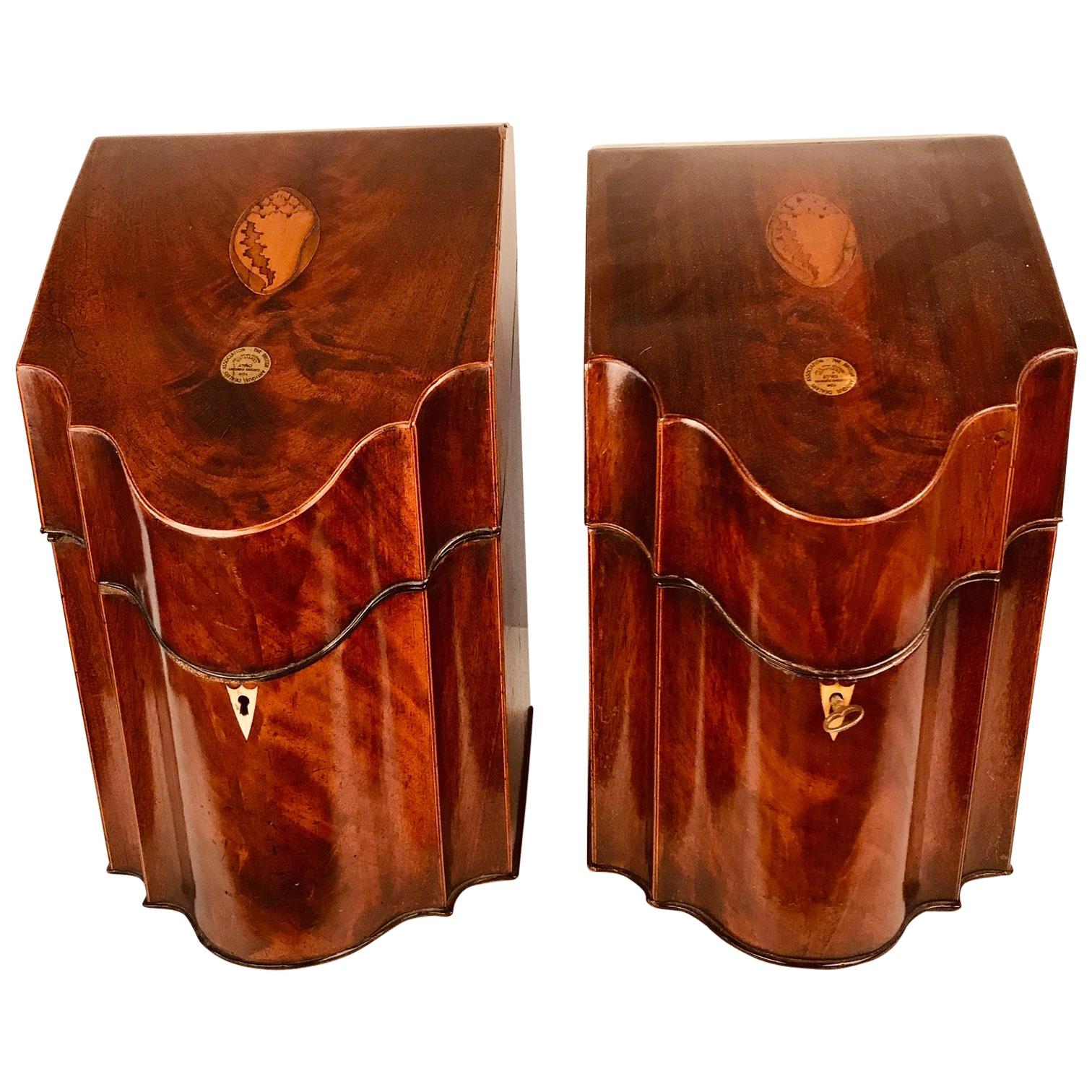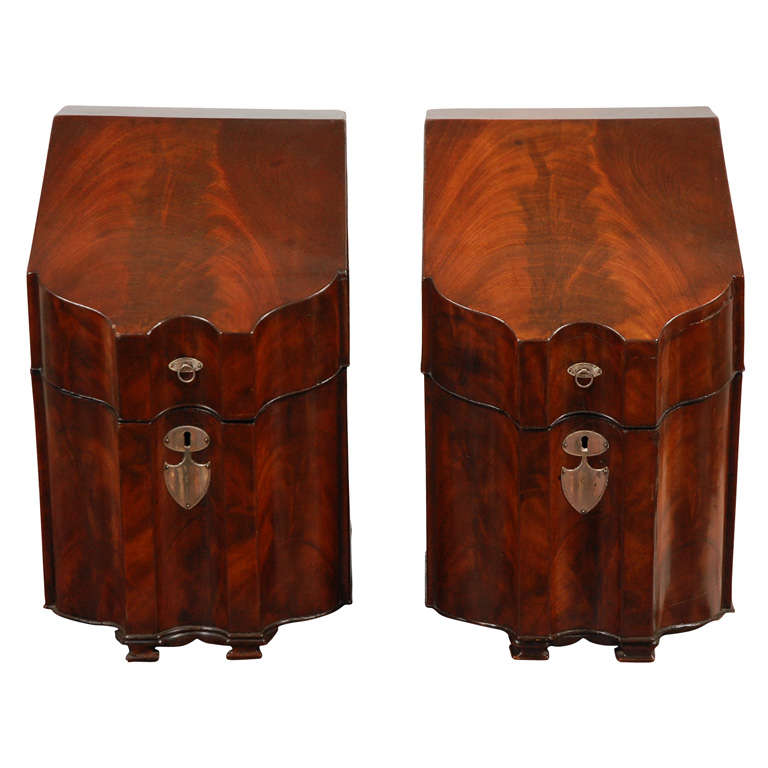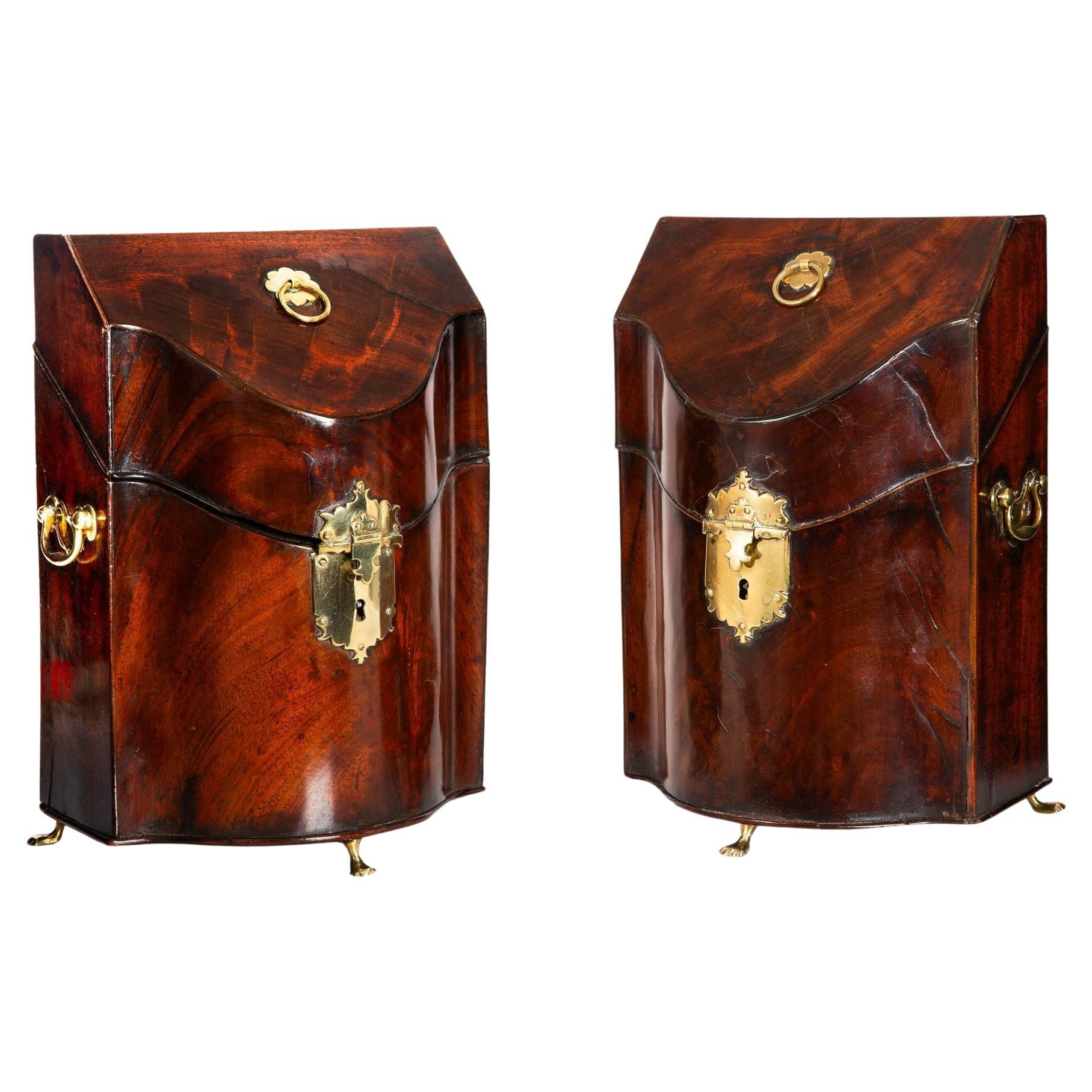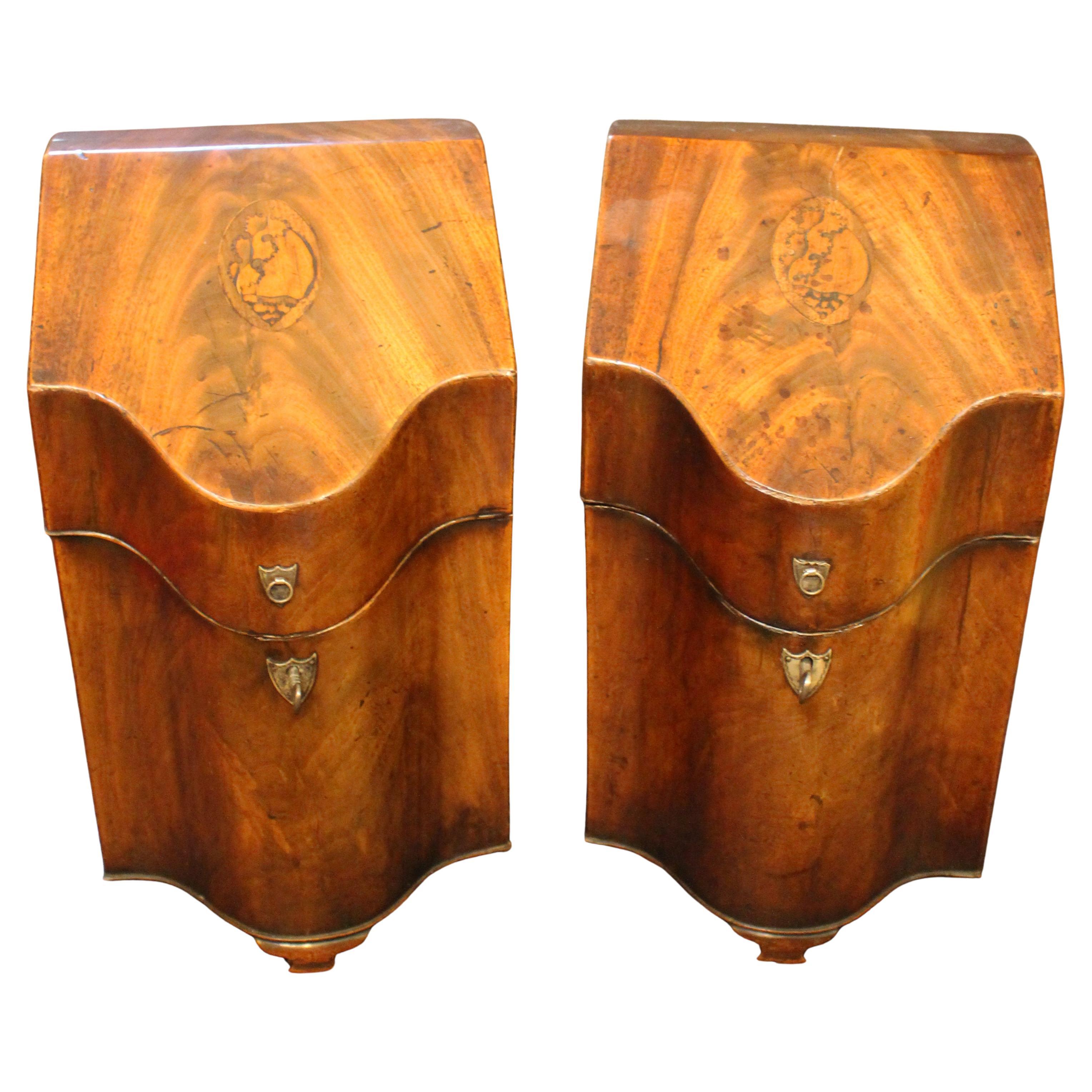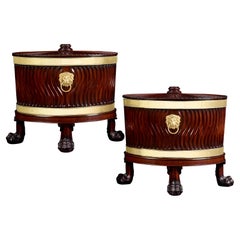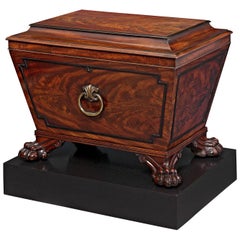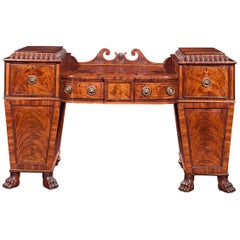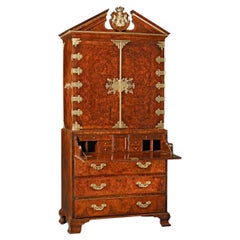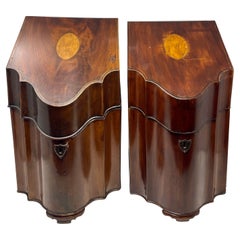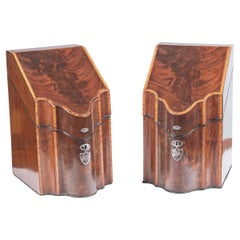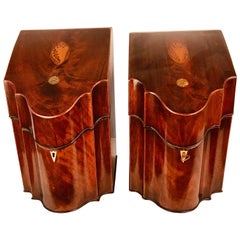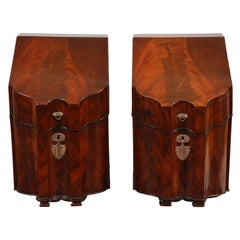Items Similar to 18th Century George III Mahogany Footed Knife Boxes
Want more images or videos?
Request additional images or videos from the seller
1 of 5
18th Century George III Mahogany Footed Knife Boxes
$18,500per set
£14,002.52per set
€16,123.68per set
CA$26,318.18per set
A$28,509.10per set
CHF 15,011.20per set
MX$346,041.55per set
NOK 187,208.52per set
SEK 177,001.26per set
DKK 120,367.94per set
About the Item
An exceedingly rare and important pair of George III-period mahogany knife boxes of exceptional quality and condition. The boxes are of serpentine form with refined crossbanded and chevron inlay work along the edges and silver mountings on the façade. Great care was taken with the inlay work on the interior of the boxes, with intricate borders encircling each storage slot and an eight-point nautical star beneath the lid. Giving the set an air of lightness is the inclusion of feet upon which each box rests. The fact that they have survived more than 200 years in their superb, original condition, when many knife boxes were converted to suit other needs, is testament to their superior craftsmanship and beauty,
circa 1790.
Measures: 9 1/2" wide x 13 1/2" deep x 17" high.
- Dimensions:Height: 17 in (43.18 cm)Width: 9.5 in (24.13 cm)Depth: 13.5 in (34.29 cm)
- Sold As:Set of 2
- Style:George III (Of the Period)
- Materials and Techniques:Serpentine,Inlay
- Place of Origin:
- Period:
- Date of Manufacture:circa 1790
- Condition:
- Seller Location:New Orleans, LA
- Reference Number:Seller: 30-30101stDibs: LU891113201391
About the Seller
5.0
Recognized Seller
These prestigious sellers are industry leaders and represent the highest echelon for item quality and design.
Established in 1912
1stDibs seller since 2010
112 sales on 1stDibs
Typical response time: 8 hours
- ShippingRetrieving quote...Shipping from: New Orleans, LA
- Return Policy
Authenticity Guarantee
In the unlikely event there’s an issue with an item’s authenticity, contact us within 1 year for a full refund. DetailsMoney-Back Guarantee
If your item is not as described, is damaged in transit, or does not arrive, contact us within 7 days for a full refund. Details24-Hour Cancellation
You have a 24-hour grace period in which to reconsider your purchase, with no questions asked.Vetted Professional Sellers
Our world-class sellers must adhere to strict standards for service and quality, maintaining the integrity of our listings.Price-Match Guarantee
If you find that a seller listed the same item for a lower price elsewhere, we’ll match it.Trusted Global Delivery
Our best-in-class carrier network provides specialized shipping options worldwide, including custom delivery.More From This Seller
View AllGeorge III Mahogany Wine Cooler Pair
Located in New Orleans, LA
This rare and important pair of George III mahogany wine coolers epitomizes the graceful Neoclassical aesthetic championed in the Georgian style. Crafted of the finest quality mahoga...
Category
Antique 19th Century English Georgian Wine Coolers
Materials
Ormolu, Zinc
$64,500 / set
Regency Mahogany Cellarette
Located in New Orleans, LA
This refined Regency-period wine cellarette is crafted of rich mahogany and boasts beautifully carved details. The sarcophagus form is distinguished by ebon...
Category
Antique Early 19th Century English Regency Wine Coolers
Materials
Brass, Lead
$26,850
19th Century Regency Mahogany Pedestal Sideboard
Located in New Orleans, LA
This monumental English mahogany sideboard captures the luxury of the Regency era in grand style. Crafted in the neoclassical taste, the sideboard evokes the stately forms of ancient...
Category
Antique 19th Century English Regency Sideboards
Materials
Mahogany
King George I Ambassadorial Secrétaire-Cabinet
Located in New Orleans, LA
This highly important secrétaire-cabinet was crafted for and specially ordered by King George I for the British Ambassador to Russia. From its craftsmanship and materials to its exceptional artistry, it is a work of royal and historic significance that exudes power in each and every detail. The broken pediment at its apex features the simplified royal coat of arms bearing the king’s crown, while the interior is adorned by portraits of the British Royal Family. Placed within the ambassador’s St. Petersburg home, this entirely unique piece of furniture would have been a potent reminder of England's grandeur and political importance.
Relations between England and Russia during this period were at an all-time high. Peter the Great had traveled to England in 1698 as part of his widely known “Grand Embassy” tour, wherein he attempted to gain foreign support against the Ottoman Empire. He spent a period of nearly four months there, meeting with King William III and his court on numerous occasions. Noted academic Arthur MacGregor wrote concerning the impact of the trip, “For two decades following Peter's visit, British influence in Russia reached a peak. It manifested itself in social custom, in craft practice and in ships and naval organization... it reached a significant sector of the population before relations cooled once again and the two nations pulled back from this era of unprecedented cordiality.”
First and foremost, however, it is a reminder of British might and influence. By the reign of King George I, England had come into its own as a world power. Unique in its design, this cabinet is a reflection of the country’s might. It is crafted from the highest-quality solid walnut and burr walnut adorned by gilded lock plates and engraved hinges. The presence of ormolu at its apex and lining the doors was a rarity for this period, and its addition makes manifest the importance of the design.
The outer doors open to reveal multiple interiors, including fifteen separate drawers around a central cupboard; the cupboard doors each bear mezzotint portraits of George I and his father, Ernest Augustus, Elector of Hanover. An etching after the portrait of George I dating to circa 1716 is in London’s Royal Academy. A second, inner pair of doors are adorned by mezzotints of the Prince and Princess of Wales (later Queen Caroline and George II), which are both after portraits by Sir Godfrey Kneller dated 1716 in the Royal Collection. A final portrait is revealed on the very interior of the cabinet, where a mezzotint of Frederick, Anne, Amelia and Caroline, children of the Prince of Wales, resides. An etching (circa 1715-1720) after this portrait can be found in the National Portrait Gallery (London).
Apart from its abundance of royal portraiture, the cabinet features stunning painted decoration, including floral designs as well as clouds, birds and trees in a bucolic motif reminiscent of Eden. Its lower portion is a study in both form and function, featuring a fitted secrétaire-drawer above three additional drawers for storage. The cabinet appears in The Shorter Dictionary of English Furniture by R. Edwards from 1964, a text that is regarded as the bible of British furniture design. Edwards describes it as a “writing cabinet...given by George I to the British Ambassador at the Russian court.”
The cabinet was likely made for the 18th-century German diplomat and writer Friedrich Christian Weber, who represented English interests at the Russian court from 1714 until 1719. Although Weber’s tenure as ambassador was relatively short, while in St. Petersburg, he authored his account entitled Das veraenderte Russland (The Present State of Russia), which was published in three volumes in 1721, 1739 and 1740. It may, however, also have been made for George Douglas, 2nd Earl of Dumbarton, who served as ambassador alongside Weber in 1716. Diplomatic relations ceased between the two countries in 1721.
In 1928, the cabinet appeared for sale at the International Exhibition of Antiques & Works of Art in Olympia. It had previously been in the collection of the Woltner family of Bordeaux, the celebrated vintners who owned the estate Château Laville Haut-Brion and produced wine of the same name. According to the family, Monsieur Woltner was given the cabinet as a gift from an aunt who lived in Russia for many years. After leaving the Woltner collection, the cabinet was acquired by William Berry...
Category
Antique 18th Century English Georgian Secretaires
Materials
Brass
Rococo Style Pair of Twin Beds
By François Linke
Located in New Orleans, LA
Superior craftsmanship and elegant adornment characterize these exceptional, matching pair of mahogany twin beds by François Linke, the most influenti...
Category
Antique 19th Century French Louis XVI Beds and Bed Frames
Materials
Bronze
$44,500 / set
Regency-Period Rosewood Card Tables
Located in New Orleans, LA
These exceptional Regency card tables were designed with dual purposes in mind. Crafted of rosewood, the tables serve as attractive console tables when closed. When opened, the table...
Category
Antique 19th Century English Regency Card Tables and Tea Tables
Materials
Brass
You May Also Like
Pair Antique English George III Mahogany Cutlery or Knife Boxes, Circa 1820-1830
Located in New Orleans, LA
Pair Antique George III mahogany with inlay cutlery or knife boxes, circa 1820-1830.
Category
Antique Early 19th Century English George III Knife Boxes
Materials
Mahogany
19th Century Pair of Mahogany and Satinwood Knife Boxes
Located in Dublin 8, IE
19th Century pair of mahogany and satinwood knife boxes with one later converted into a box for storing bottles and the other for storing drinking glasses. Featuring satinwood border...
Category
Antique 19th Century Knife Boxes
Materials
Mahogany, Satinwood
Pair of George III Mahogany Knife Boxes
Located in Montreal, QC
This pair have the typical shape of boxes from this period, with shaped serpentine front, sloped hinged lid, and boxwood and ebony lines. Each cover is inlaid with an oval patera and...
Category
Antique Early 19th Century British George III Knife Boxes
Materials
Mahogany
Pair of 18th Century English Mahogany Knife Boxes
Located in Los Angeles, CA
Pair of 18th century English Mahogany Knife Boxes with Sterling Silver hardware and original fitted interiors.
Category
Antique 18th Century and Earlier English Knife Boxes
Materials
Mahogany
Fine Pair of English George III Period Antique Mahogany Boxes circa 1780
Located in Shippensburg, PA
GEORGE III FLAMED MAHOGANY SERPENTINE BOXES ON ANIMAL FEET
England, circa 1780 the cutlery divider removed, otherwise fine original condition
Item # 403ONQ02L
An absolutely gorgeou...
Category
Antique 18th Century English George III Knife Boxes
Materials
Brass
Circa 1765-1780 English Pair of George III Knife Boxes
Located in Chapel Hill, NC
1765-1780 Pair of George III Knife Boxes, English. Raised on ogee bracket feet reflecting the box form. Conch shell inlaid lids reveal original fitted interiors with extensive barber...
Category
Antique Late 18th Century English George III Knife Boxes
Materials
Silver Plate
More Ways To Browse
Cutlery Box
Antique Cutlery Box
Bronze Knife
English Antique Cutlery
Antique English Knife Box
Mahogany Cutlery Box
Antique Georgian Knife Box
Pair Mahogany Urns
Antique Cutlery Tray
Silver Carving Knife Set
18th Century Cutlery
Knife Urn
Pair Of Knife Urns
Cutlery Urn
Antique Bone Knife
Antique Boning Knife
Vintage Knife Solingen Germany
Georgian Silver Cutlery
